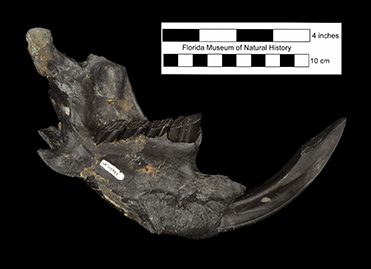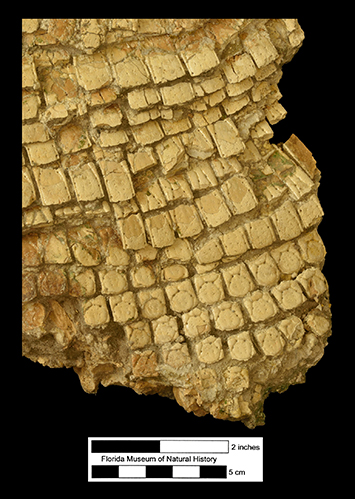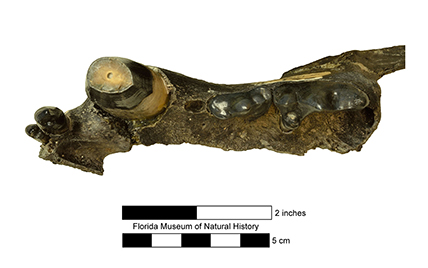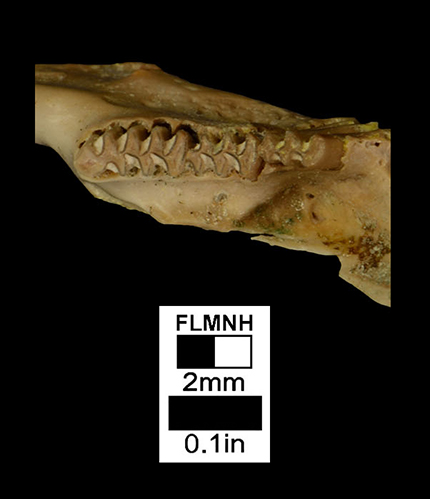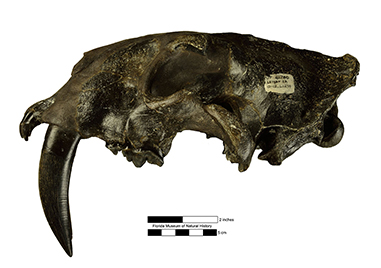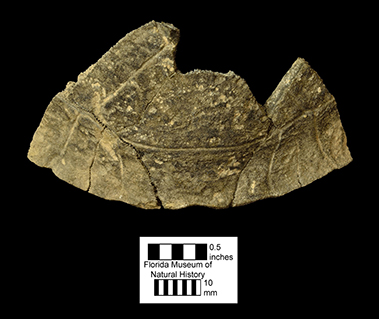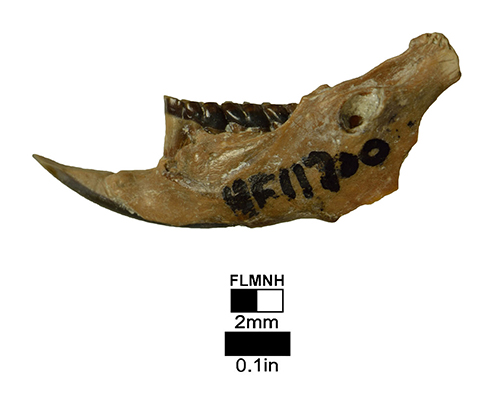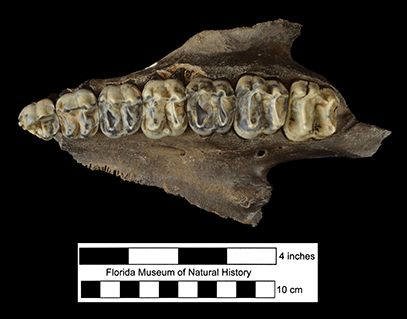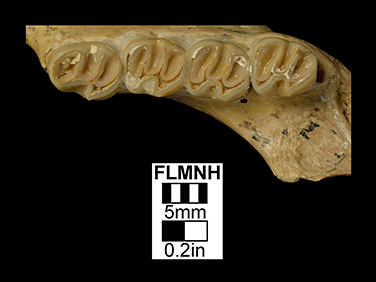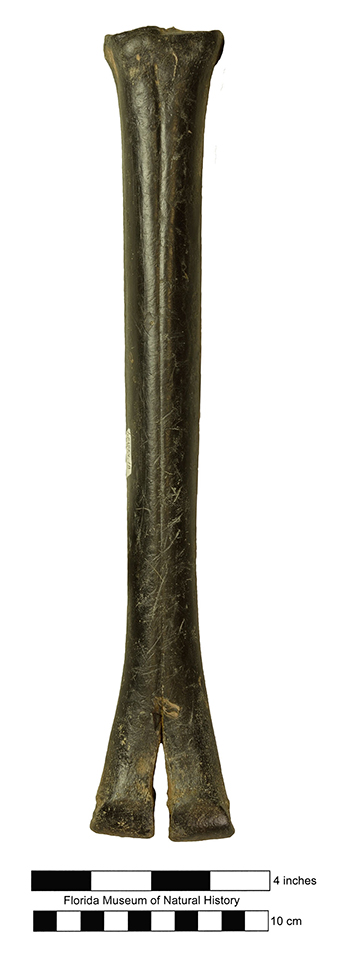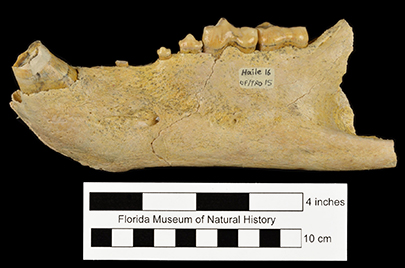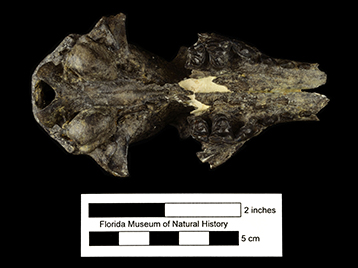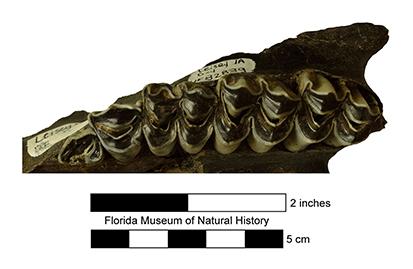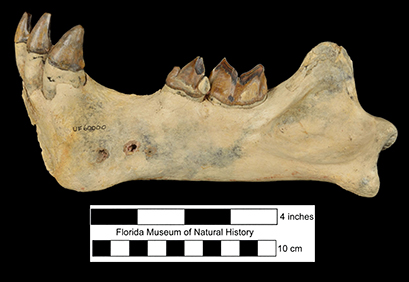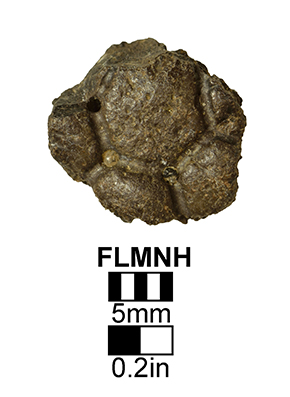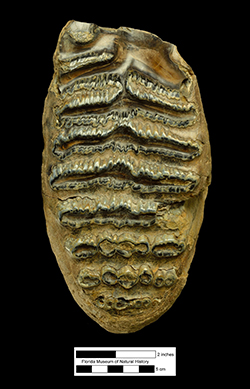
Defining taxon: first appearance of Mammuthus south of 55° N latitude (Bell et al., 2004)
Basis of name: Savage (1951) based the name on the Irvington District in Fremont, California, which is in the San Francisco Bay Area. It was the location of a Pleistocene vertebrate fauna that contained Mammuthus and numerous other large herbivores but which notably lacked Bison.
The Irvingtonian NALMA is represented by several hundred individual vertebrate fossil sites distributed from southern Canada to central Mexico (Bell et al., 2004). There are about 70 Irvingtonian sites in Florida; about half of them from either Polk or Hillsborough counties (Table 1). The Irvingtonian is divided into three subintervals: the Ir1 from 1.6 to 1.0 million years ago; the Ir2 from 1.0 million to 600,000 years ago; and the Ir3 from 600,000 to 250,000 years ago.
Index species for Ir1 in Florida: Nothrotheriops texanus, Microtus australis, Ondatra annectens, Sigmodon libitinus, and Synaptomys morgani
Significant Ir1 localities and faunas in Florida: Haile 16A and 21A; Leisey Shell Pit 1A, 3A, and 3B; Pool Branch Site; Tucker Borrow Pit; and Crystal River Power Plant
Index species for Ir2 in Florida: Neofiber leonardi
Significant Ir2 localities and faunas in Florida: McLeod Limerock Pit
Index species for Ir3 in Florida: Platygonus cumberlandensis, Urocyon minicephalus and Microtus aratai
Significant Ir3 localities and faunas in Florida: Coleman 2A; LaBelle Highway Pit; Tri-Britton Site; Sebastian Canal
Characteristic species for the Irvingtonian in Florida: Trachemys scripta, Hesperotestudo mlynarskii, Melagris anza or M. leopoldi, Ajaia chione, Gymnogyps kofordi, Holmesina floridanus, Pachyarmatherium leiseyi, Paramylodon harlani, Megalonyx wheatleyi, Canis armbrusteri, Canis edwardii, Arctodus pristinus, Panthera onca, Smilodon gracilis, Xenosmilus hodsonae, Mylohyus fossilis, Platygonus vetus, Hemiauchenia macrocephala, Palaeolama mirifica, Equus (Hemionus) sp., Tapirus haysii, Tapirus veroensis, Cuvieronius tropicus, Mammut americanum, and Mammuthus columbi.
Gallery of Irvingtonian Florida Fossils
Major extinctions: There are no widespread mass extinction events during the Irvingtonian NALMA. Extinctions of species (and some genera) occurred at background levels. Three mammalian genera became extinct in Florida during the Irvingtonian: Pachyarmatherium, Xenosmilus, and Atopomys, along with the subgenus Equus (Hemionus). Among the more significant species from Florida to become extinct during or at the end of the Irvingtonian are Hesperotestudo mlynarskii, Gavia concinna, Meleagris anza, Holmesina floridanus, Glyptotherium arizonae, Eremotherium eomigrans, Canis edwardii, Canis armbrusteri, Smilodon gracilis, Arctodus pristinus, Sigmodon libitinus, Atopomys texensis, Sylvilagus webbi, Platygonus cumberlandensis, and Tapirus haysii.
Comments: Irvingtonian sites and faunas are far fewer in number in Florida than for the Rancholabrean (Table 1), but several of them are very large and diverse, so the interval is now very well studied, especially the Ir1. In addition to the presence of Mammuthus, Irvingtonian sites can be distinguished from older Blancan sites by the presence of Megalonyx wheatleyi, Canis armbrusteri, Castoroides dilophidus, Erethizon dorsatum, Geomys pinetis, Sylvilagus palustris, and Palaeolama mirifica. In addition to the index species listed above, Ir1 faunas in Florida are characterized by the unique co-occurrence of Glyptotherium arizonae, Holmesina floridanus, Megalonyx wheatleyi, Canis armbrusteri, Canis edwardii, Smilodon gracilis, and Platygonus vetus. Ir2 faunas are characterized by the unique co-occurrence of Holmesina septentrionalis, Megalonyx wheatleyi, Sigmodon bakeri, Smilodon gracilis, Panthera onca, and Tapirus haysii. And Florida Ir3 faunas are characterized by the unique co-occurrence of Didelphis virginiana, Canis armbrusteri, Arctodus pristinus, Neofiber alleni, Tapirus veroensis, and Platygonus cumberlandensis.
Bell et al. (2014) placed Haile 16A in the late Blancan based on the presence of Sylvilagus webbi, Orthogeomys propinetis, and Atopomys texensis. Morgan and Hulbert (1995) assigned Haile 16A to what is now termed Ir1 due to its having more derived species in a number of rodent genera than are found in Florida Blancan sites, including Erethizon, Microtus, Peromyscus, Sigmodon, and Synaptomys. Atopomys texensis is known from the Irvingtonian of Texas, Maryland, and West Virginia, so its presence at Haile 16A should not be used to justify a Blancan age. Overall the small mammal fauna of Haile 16A shows greater similarity with Florida Ir1 sites than it does with late Blancan sites. The absence of Mammuthus is not considered relevant, as Haile 16A completely lacks proboscideans.
Table 1. Number of Pleistocene vertebrate fossils sites known from counties in Florida, subdivided by land mammal age.
| Rancholabrean | Irvingtonian | Blancan | |
| ALACHUA |
72 |
5 |
5 |
| BREVARD |
9 |
4 |
0 |
| BROWARD |
1 |
0 |
0 |
| CHARLOTTE |
3 |
8 |
16 |
| CITRUS |
18 |
1 |
16 |
| COLLIER |
0 |
1 |
1 |
| COLUMBIA |
60 |
0 |
12 |
| DADE |
3 |
0 |
0 |
| DE SOTO |
17 |
1 |
8 |
| DIXIE |
8 |
0 |
0 |
| DUVAL |
3 |
0 |
0 |
| FLAGLER |
5 |
0 |
0 |
| GILCHRIST |
6 |
1 |
1 |
| GLADES |
3 |
0 |
1 |
| HARDEE |
21 |
1 |
0 |
| HENDRY |
5 |
4 |
4 |
| HERNANDO |
1 |
0 |
0 |
| HIGHLANDS |
0 |
0 |
1 |
| HILLSBOROUGH |
7 |
15 |
0 |
| INDIAN RIVER |
6 |
0 |
0 |
| JACKSON |
7 |
0 |
0 |
| JEFFERSON |
11 |
0 |
0 |
| LAFAYETTE |
3 |
1 |
0 |
| LAKE |
3 |
0 |
0 |
| LEE |
2 |
0 |
2 |
| LEON |
0 |
0 |
1 |
| LEVY |
45 |
1 |
2 |
| LIBERTY |
0 |
0 |
1 |
| MADISON |
1 |
0 |
1 |
| MANATEE |
9 |
1 |
0 |
| MARION |
59 |
0 |
2 |
| MARTIN |
2 |
0 |
0 |
| NASSAU |
3 |
0 |
0 |
| OKEECHOBEE |
0 |
0 |
1 |
| ORANGE |
1 |
1 |
0 |
| PALM BEACH |
2 |
3 |
0 |
| PINELLAS |
19 |
0 |
1 |
| POLK |
5 |
20 |
0 |
| PUTNAM |
9 |
0 |
3 |
| SARASOTA |
16 |
3 |
19 |
| SEMINOLE |
5 |
0 |
0 |
| ST. JOHNS |
4 |
0 |
0 |
| ST. LUCIE |
3 |
0 |
0 |
| SUMTER |
6 |
1 |
1 |
| SUWANNEE |
12 |
0 |
1 |
| TAYLOR |
31 |
0 |
0 |
| VOLUSIA |
6 |
0 |
0 |
| WAKULLA |
10 |
0 |
0 |
| WALTON |
1 |
0 |
0 |
| total |
523 |
72 |
100 |
Sources
- Text Author: Richard C. Hulbert Jr.
- Image Gallery: Natali Valdes
- Original Publication Date: June 18, 2015
- Last Edited On: June 19, 2015
References
Bell, C. J., E. L. Lundelius Jr, A. D. Barnosky, R. W.Graham, E. H. Lindsay, D. R. Ruez Jr., H. A. Semken Jr., S. D. Webb, and R. J. Zakrzewski. 2004. The Blancan, Irvingtonian, and Rancholabrean mammal ages. Pp. 232–314 in M. O. Woodburne (ed.), Late Cretaceous and Cenozoic Mammals of North America. Columbia University Press New York.
Hulbert Jr., R. C. (ed.) 2001. The Fossil Vertebrates of Florida. University Press of Florida: Gainesville.
Morgan, G. S. and R. C. Hulbert, Jr. 1995. Overview of the geology and vertebrate biochronology of the Leisey Shell Pit local fauna, Hillsborough County, Florida. Bulletin of the Florida Museum of Natural History 37:1-92.
Webb, S. D. 1974. Chronology of Florida Pleistocene mammals. Pp. 5-31 in S. D. Webb (ed.), Pleistocene Mammals of Florida. University of Florida Press, Gainesville.
